Road trip: Wildflowers of the Mississippi Valley
A spring quest leads to Minnesota bluff country and Wisconsin river towns.
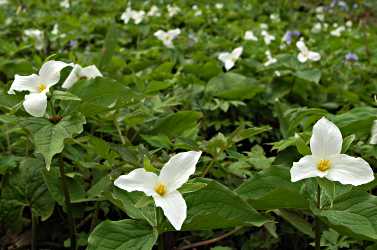
© Torsten Muller
In May, the woods are full of people on the hunt.
Some are stalking morel mushrooms. Others are trying to bag a turkey or spot a rare warbler.
The rest of us are content to chase wildflowers. For one thing, we're guaranteed success.
"We usually look for wildflowers, because there are lots of them around, and unlike wildlife, they don't run away," said Dave Hanke of Shakopee, Minn., who was photographing in Whitewater State Park one May. "And if one thing isn't blooming, something else is."
Finding a certain wildflower can take a little effort. But your chances are especially good in the southeast corner of Minnesota and along the Mississippi River in southwest Wisconsin.
Zumbro Falls SNA
Canoeing down the Zumbro River in southeast Minnesota one May with my husband, I pulled in at the Zumbro Falls Woods state natural area on the west bank to look at the Virginia bluebells, which lined the banks in bright-blue clusters.
Under the basswood canopy, there was a carpet of false rue anemone, spring beauty and lacy beds of Dutchman's breeches.
My quarry, however, was on the opposite bank, where the jeweled shooting star supposedly blooms on dry limestone cliffs.
Scrabbling along the rock, barely keeping my footing — and completely forgetting about the rattlesnakes that frequent warm rock in spring — I did see a stunning clump of woollypod milk-vetch, with 10 deep-purple tubular petals on each stem, and an orange-gold clump of hoary puccoon.
Farther up, I found a violet wood sorrel and delicate columbines shooting up from rock crevices.
The shooting stars, though, were nowhere to be seen.
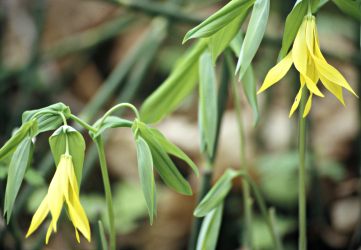
© Beth Gauper
Whitewater State Park
The next day, we went to Whitewater State Park, where Judy Shepard was leading a wildflower walk.
Along the trail that leads to the cart-in camping sites, she pointed out a full palette of spring ephemerals — wild ginger, toothwort, bird-foot violet, bloodroot, buttercup, Jack-in-the-pulpit and false rue anemone, which had turned the forest floor white.
Marsh marigolds were blossoming in the muck around a creek, and that's where we found Dave and Terri Hanke. Earlier, they'd caught the peak of the pasque flower display at River Terrace Prairie state natural area just to the north, near Cannon Falls, by checking on the first two weekends in April, long before their normal peak.
"Timing is so important for these spring flowers," Terri Hanke said. "Their life span is so short."
Meanwhile, Judy Shepard had some tips for me: nearby Carley State Park for bluebells, Beaver Creek Valley State Park for an unusually good display of large-leafed trout lilies — and the Brady's Bluff Trail in Perrot State Park for the jeweled shooting star, which she'd seen only the day before.
"It's just carpeted," she said. "It's really gorgeous."
We headed for Trempealeau, on the Wisconsin side of the Mississippi between La Crosse and Winona.
Mound Prairie SNA
But on the way, we stopped at Mound Prairie state natural area between Houston and Hokah, where the jeweled shooting star is supposed to grow on the steep goat prairies.
Standing on the shoulder of Minnesota 16, also Historic Bluff Country Scenic Byway, we looked up at the first bald, lumpy mound and saw nothing but parched grass.

© Beth Gauper
Climbing, we started to see pussytoes at our feet, then hoary puccoon and Indian paintbrush. The seed heads of prairie smoke waved in the breeze, near the star-shaped petals of blue-eyed grass.
And blooming everywhere was an odd, pale-yellow flower that, from above, looked just like a pinwheel.
It turned out to be wood betony, or lousewort, named because farmers once thought cattle became infested with lice when grazing on them.
It was an amazing display of spring prairie flowers — but no shooting stars.
Perrot State Park
It was already 6:30 p.m. when we arrived in Trempealeau and bought a one-hour pass at Perrot State Park.
Following the trail up the western flank of Brady's Bluff, we passed through Fern Gully, a cool nook where Dutchman's breeches and ferns clung to the side of a rock face. Around the corner, trillium and bellwort grew on a shady hillside.
And then we saw them — fragrant jeweled shooting stars as far as the eye could see, up and down a hillside, more copious than dandelions and much lovelier.
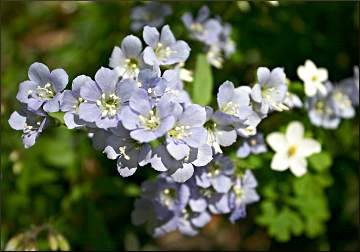
© Beth Gauper
The view was incredible too. We were exactly opposite the hill French explorers called La Montagne Qui Trempe a l'eau, the mountain that soaks in the water, and through a curtain of trees, we could see it as well as the surrounding river and sloughs.
We saw more shooting stars while continuing on the CCC-built trail, as well as rock cress, columbine and starry Solomon's plume.
At the top of the 520-foot bluff, we took in the magnificent view and learned that this magic place would have been part of Minnesota, had glacial debris not forced the Mississippi to cut a new channel around La Montagne and the park, placing them at the edge of Wisconsin.
By the time we headed home along Lake Pepin, we felt we'd done pretty well, wildflower-wise. Still, we had one more stop.
Rustic Road 51
Just south of Maiden Rock, Wis., we turned onto County Road AA, from which Rustic Road 51 follows Pine Creek.
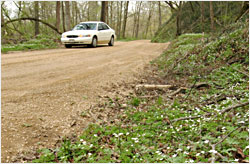
© Torsten Muller
One of more than 100 stretches of country road that preserve remnants of old Wisconsin (see Wisconsin's Rustic Roads ), the packed-dirt road was covered by a canopy of budding trees and lined with false rue anemone and spring beauty.
We crawled along in the car for a while, but then we had to get out and walk.
All the spring ephemerals were there, plus fiddlehead ferns and watercress in the stream and horsetail rushes covering the hillside. We saw hundreds of bellwort and beds of Dutchman's breeches and their cousin, white squirrel corn.
Only a mile farther, the floral display jumped ahead a week, with glossy green hillsides dotted with large-flowered trillium, blue wood phlox and spiderwort.
Strolling on the road, I spotted purple ground ivy, tiny yellow winter cress, early meadow rue and even a few yellow fawn lilies, with peach-veined backs.
For variety and nonstop coverage, it beat even Nerstand-Big Woods State Park in Minnesota, long the standard for spring wildflowers.
Spring wildflowers in deciduous forests usually peak in mid-May, and then they'll be replaced by May apple, trillium, wild geranium, columbine and Solomon's seal.
In June, orchid-lovers will start to haunt prairies, bogs and ditches in search for as many of Minnesota's 42 species as they can find, including the state flower, the showy lady's slipper.
The next big display comes in late summer, when blazing star, aster, goldenrod and purple coneflower bloom, as well as tick-trefoil, wild indigo, leadplant and dozens of members of the daisy family.
So if you miss one show, you can always catch the next.
Trip Tips: Wildflowers in the Mississippi River Valley
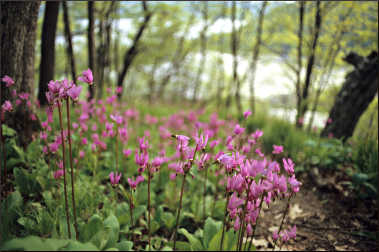
© Beth Gauper
When to go: The first two weeks of May usually are peak for spring ephemerals, and the second wave of spring wildflowers follows during the the last two weeks of May and first week of June.
Where to go: Here's a great driving loop to take from the Twin Cities, heading southeast through Minnesota bluff country and returning along the Mississippi River.
Nerstrand-Big Woods State Park: This park near Northfield is famous for its large variety of spring ephemerals, which thrive under the hardwood forest canopy. The park office has a loose-leaf binder of pictures that help you identify types.
Zumbro Falls Woods: This scientific and natural area can be reached from the Zumbro River or, on the western side, by a parking lot at the end of Township Road 7, off U.S. 63 south of Zumbro Falls .
The clifftops on the eastern side of the river can be reached by taking the first right off Minnesota 60 east of Zumbro Falls.
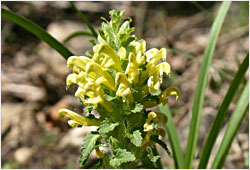
© Beth Gauper
Whitewater State Park: This picturesque bluff-country park just north of St. Charles holds one of Minnesota's best variety of spring ephemerals; one of the best places to see them is on the path to the walk-in campsites.
In May, it's also a hot spot for fly fishing and morel-mushroom hunting. For more, see Minnesota's spring mecca.
Carley State Park: This little park, where white pines line a sunken bowl in the middle of farmland, is 12 miles northwest of Whitewater.
Thousands of bluebells and clouds of false rue anemone cover an oxbow in the North Branch of the Whitewater River.
Along with the nearby town of Plainview, it celebrates Bluebell Festival in early May.
Mound Prairie SNA: This scientific and natural area includes three goat prairies on each side of Minnesota 16, between Houston and Hokah , and contains many rare wildflowers in early and late summer as well as superb views of the surrounding countryside. Watch out for rattlesnakes.

© Beth Gauper
Perrot State Park: Reached from the western edge of Trempealeau, Wis., this park is a jewel, and not just for its shooting stars. It's surrounded by wildlife refuges and canoeing trails, and the Great River State Trail goes through its northern edge.
Rustic Road 51: It's a four-mile stretch off County Road AA, just south of Maiden Rock on the Wisconsin side of Lake Pepin.
If possible, walk it. The Legion park along the road also is a nice place for a picnic.
More information
For more, see Where to find spring wildflowers.
For photography tips, see Tiptoeing through the toothwort.
For tips on finding morel mushrooms, see Searching for morels.